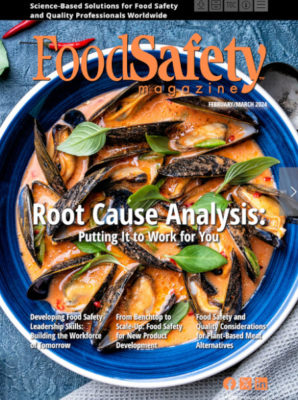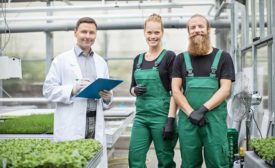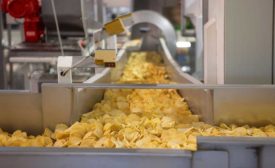Home » Publications » Food Safety Magazine
Our Publications
Please select a publication below.
Food Safety Magazine

February/March 2024
Cover Story
Back to TopInvesting the time and effort to clearly define the problem that needs to be solved is a critical step in getting to the true root cause
Read More
Features
Back to TopFood Safety and Quality Considerations in the Production of Plant-Based Meat Alternatives
Each step during manufacturing and distribution introduces potential challenges and opportunities for maintaining food safety and quality of plant-based meat products
February 13, 2024
Developing Food Safety Leadership Skills: Building the Workforce of Tomorrow
What does it take to be a great food safety leader?
February 13, 2024
Columns
Back to TopCollective Responsibility for Food Safety and Quality in Food Manufacturing
Food safety and quality are not just the responsibility of one team; they are the shared responsibility of every individual within the organization
February 13, 2024
From Benchtop to Scale-Up: Food Safety Considerations for New Product Development
A robust product development process builds control into the process so that food safety variables are properly considered
February 13, 2024
Building a Culture of Hygiene in the Food Processing Plant
One of the crucial building blocks for a successful food safety or quality culture is basic food hygiene
February 13, 2024
The Evolution of FDA CORE: Adaptive Response to Outbreak-Related Challenges
Since the CORE Network was established in 2011, its dedicated staff has worked to adapt to an ever-changing foodborne illness outbreak investigation landscape
Stelios Viazis Ph.D.
Christina K. Carstens Ph.D., M.S.
Lindsay Walerstein, M.P.H.
Marie Armstrong M.P.H.
Angela Fields M.P.H.
Tyann Blessington Ph.D., M.S., M.P.H.
Cerisé Hardy M.P.H.
Sharon Seelman M.S., M.B.A.
Brett Weed M.P.H., M.S.
February 13, 2024
Strategies for Managing Temporary Workforce in Food Manufacturing
Temporary employees can be a cost-effective staffing resource for a food manufacturing facility; however, they can also bring some challenges
February 13, 2024
How FDA's Foreign Supplier Verification Programs (FSVP) Help Meet Food Safety Standards
The key to effective FSVP compliance is creating a culture of food safety within an importing firm
February 13, 2024
Rapid Testing Methods—Processor Preferences
Which rapid microbiological test methods are preferred by food processors, and what attributes of rapid tests are most important to them?
February 13, 2024
Food Safety Culture and the Local Food Movement
To what extent do established food safety culture cornerstones apply to the local foods segment of the food industry?
February 13, 2024
Beneficial AI: Safe, Secure, and Trustworthy Artificial Intelligence for Food Safety
AI can help ensure food safety by analyzing patterns and trends that might not be readily apparent to human analysts
February 13, 2024
Never miss the latest news and trends driving the food safety industry
eNewsletter | Website | eMagazine
JOIN TODAY!Copyright ©2024. All Rights Reserved BNP Media.
Design, CMS, Hosting & Web Development :: ePublishing












